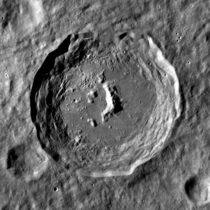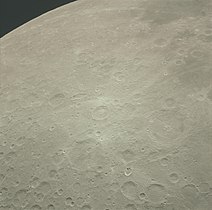
Copernicus is a lunar impact crater located in eastern Oceanus Procellarum. It was named after the astronomer Nicolaus Copernicus. It typifies craters that formed during the Copernican period in that it has a prominent ray system. It may have been created by debris from the breakup of the parent body of asteroid 495 Eulalia 800 million years ago.

Fra Mauro is the worn remnant of a walled lunar plain. It is part of the surrounding Fra Mauro formation, being located to the northeast of Mare Cognitum and southeast of Mare Insularum. Attached to the southern rim are the co-joined craters Bonpland and Parry, which intrude into the formation forming inward-bulging walls. The crater is named after Italian geographer Fra Mauro.

Plinius is a prominent lunar impact crater on the border between Mare Serenitatis to the north and Mare Tranquilitatis to the south. Its diameter is 41 km. The crater is named after the Roman natural scientist and author Pliny the Elder. To the south-southeast of Plinius is the crater Ross, and to the northeast is Dawes. Just to the north is a system of rilles named the Rimae Plinius and touching it is the Brackett crater which is more than a crater diameter north. At the northwest edge of the rille is the Promontorium Archerusia, a cape off the western rim that encloses the Mare Serenitatis.

Petavius is a large lunar impact crater located to the southeast of the Mare Fecunditatis, near the southeastern lunar limb. Attached to the northwest rim is the smaller crater Wrottesley. To the southeast are Palitzsch, Vallis Palitzsch, and Hase. Farther to the north is the large crater Vendelinus. Petavius appears oblong when viewed from the Earth due to foreshortening. Petavius is Imbrian in age.

Burnham is a small crater located to the southeast of the crater Albategnius, in a relatively smooth area of the lunar surface. It was named after American astronomer Sherburne W. Burnham. To the southwest is Vogel.

Taruntius is a lunar impact crater on the northwestern edge of Mare Fecunditatis. It was named after ancient Roman philosopher, mathematician and astrologer Lucius Tarutius Firmanus. To the northwest is the lava-flooded crater Lawrence, and to the north lie the craters Watts and da Vinci.

Bode is a small crater located near the central region of the Moon, to the northwest of the joined craters Pallas and Murchison. It lies on a region of raised surface between the Mare Vaporum to the northeast, Sinus Aestuum to the west, and Sinus Medii to the southeast. The crater was named after German astronomer Johann Elert Bode.

Gassendi is a large lunar impact crater feature located at the northern edge of Mare Humorum. It was named after French astronomer Pierre Gassendi. The formation has been inundated by lava during the formation of the mare, so only the rim and the multiple central peaks remain above the surface. The outer rim is worn and eroded, although it retains a generally circular form. A smaller crater – Gassendi A – intrudes into the northern rim, and joins a rough uplift at the northwest part of the floor. The crater pair bear a curious resemblance to a diamond ring.
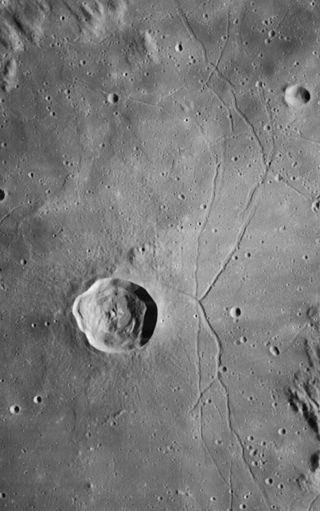
Triesnecker is a prominent lunar impact crater that is located in the Sinus Medii, near the central part of the Moon's near side. Its diameter is 25 km. It was named after Austrian astronomer Franz de Paula Triesnecker. It is located to the north-northwest of the crater Rhaeticus, and to the east-southeast of the flooded Murchison.

Eudoxus is a prominent lunar impact crater that lies to the east of the northern tip of the Montes Caucasus range. It is named after the Greek astronomer Eudoxus of Cnidus. It is located to the south of the prominent crater Aristoteles in the northern regions of the visible Moon. To the south is the ruined formation of Alexander, and the small crater Lamèch lies to the southwest.

Kepler is a lunar impact crater that lies between the Oceanus Procellarum to the west and Mare Insularum in the east. To the southeast is the crater Encke. Kepler is named for the 17th century German astronomer and mathematician Johannes Kepler.
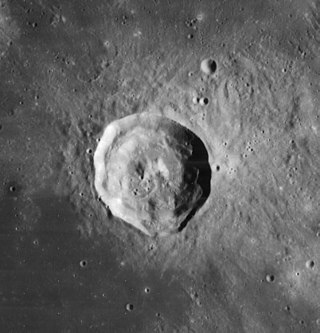
Manilius is a lunar impact crater on the northeast edge of Mare Vaporum. Its diameter is 38 km.
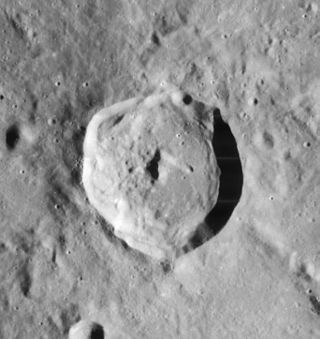
Agrippa is a lunar impact crater that is located at the southeast edge of the Mare Vaporum. It is located to the north of the crater Godin, the irregular Tempel lies just to the east. To the north and northeast, the rille designated Rima Ariadaeus follows a course to the east-southeast, reaching the western edge of Mare Tranquillitatis. It is named after the 1st century Greek astronomer Agrippa.

King is a prominent lunar impact crater that is located on the far side of the Moon, and can not be viewed directly from Earth. The crater was named after Arthur Scott King and Edward Skinner King in 1970. Prior to that, this crater was known as Crater 211. It forms a pair with Ibn Firnas, which is only slightly larger and is attached to the northeast rim of King. To the northwest is the crater Lobachevskiy, and Guyot is located an equal distance to the north-northwest.

Philolaus is a lunar impact crater that is located in the northern part of the Moon's near side. It lies within one crater diameter to the east-southeast of the flooded crater Anaximenes, and to the west of the smaller Anaxagoras. It overlies the older and heavily worn Philolaus C to the south.

Pasteur is a large lunar impact crater, approximately 233 kilometers in diameter, belonging to the category termed a walled plain. It was named after French chemist and microbiologist Louis Pasteur. It lies on the far side of the Moon as seen from the Earth, just beyond the eastern limb. The vicinity of this crater is occasionally brought into view from Earth due to librations, although not much detail can be seen.

Hahn is a lunar impact crater that is located near the northeastern limb of the Moon. The crater appears oval when viewed from the Earth due to foreshortening. It is located less than one crater diameter to the southeast of Berosus, a slightly smaller formation.

Hayn is a lunar impact crater that lies next to the northeast limb of the Moon. This location restricts the amount of detail that can be viewed from the Earth, as the western inner side is permanently hidden from sight. Observation of this crater can also be affected by libration, which can completely hide this crater from sight.

La Pérouse is a lunar impact crater that is located near the eastern limb of the Moon. It lies northwest of the larger crater Ansgarius, and to the east of Kapteyn. This crater appears foreshortened due to its location, but the rim is nearly circular when viewed from orbit.

Necho is a lunar impact crater on the far side of the Moon, and therefore cannot be seen directly from the Earth. It lies to the northeast of the larger crater Langemak, about a crater diameter to the south-southwest of Bečvář and further east is Love.


